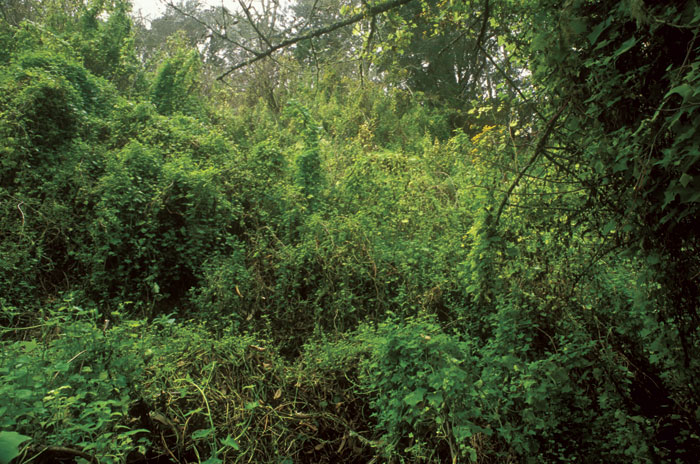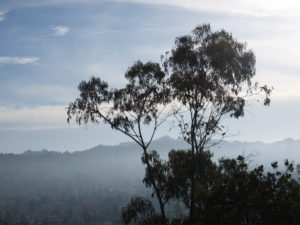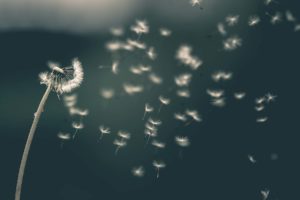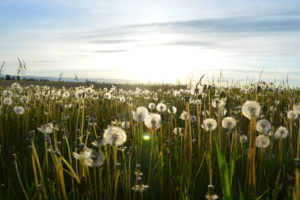Scott Portman is letting loose a South African fly into the wilds of California.
That might seem disconcerting—after all, land managers spend a lot of time and money driving out species that don’t come from here, in an effort to revive our native ecosystems. But this fly has one mission: get rid of its compatriot host plant, a South African creeper called Cape ivy (Delairea odorata) that’s strangled 10,000 acres of coastal California in a twisty mass of vines and leaves.
A landscape engulfed in Cape ivy is difficult to take in. The vine overwhelms and dominates low-growing vegetation with a sea of green, sending tentacles skyward to encircle trees in its suffocating embrace. Little can survive under Cape ivy, and it’s even toxic to animals. Rare and endemic species around rivers and streams, where Cape ivy gets its moisture, are at highest risk. Portman, an entomologist with the USDA, hopes the invasive weed will finally meet its match with the Cape ivy gall flies flitting around.
“The flies will be nonnative, but beneficial,” he says as we stroll over to a greenhouse where he’s housing the Cape ivy gall flies for testing.
We’re on the neatly trimmed grounds of the USDA Agricultural Research Service in Albany, where Portman and Patrick Moran, another research entomologist in the Exotic and Invasive Weeds Research Unit, devote their efforts to stopping weed incursions into natural lands with solutions involving biological means of control. Biocontrol, the method of suppressing one species with another, has a long and somewhat troublesome history. Some of the early attempts showed epic ignorance. Indian mongooses, for example, were brought to Hawaii in 1883 to kill off the rat population, but mongooses are omnivorous and among other species turned their attention to endemic birds. Fortunately, some lessons have been learned, and nowadays the research and permitting process to release a biological control agent is lengthy and involved. Portman assured me, “Biocontrol is not done like it used to be,” adding that today it employs rigorous scientific methods.
The place in Albany is a who’s who of California’s public (plant) enemies. We pass by a couple pots of French broom, a Mediterranean shrub that Bay Area conservationists devote thousands of hours to pulling out by hand every year; Moran is testing whether a French beetle might subdue it. In another corner, a big tub of water hyacinth, a beautiful, meddlesome Amazonian water plant that’s destroying the Delta, grows while Moran’s team subjects it to a weevil that chews away its leaves and a plant hopper that sucks its juices.
More than 65 species of biological control agents—almost all insects—have been released in California since 1945 for weed control, with some good results. But the Cape ivy project represents the first federally approved release in nearly two decades of an agent developed specifically for California wildlands.

“This is high impact,” says Doug Johnson, the executive director of California Invasive Plant Council (Cal-IPC). “Cape ivy is one of our top weeds, but it’s fairly geographically constrained. Coastal watersheds are an important habitat and that’s where Cape ivy takes off—we want to protect those.”
Portman holds up a little glass jar containing a dozen or so frenetic Cape ivy gall flies (Parafreutreta regalis). “These flies use wing-waving displays to attract mates,” Portman says.
On the same table, Portman has placed a sickly looking Cape ivy plant with yellowing leaves coiled around its support stakes. “The fly slows the plant’s growth and spread,” he explains. As the plant sends out new growth, the fly invades the shoot tips and lays eggs inside the stem. Once hatched, the fly larvae feed on the plant tissue. In response, the plant forms a purplish gall to seal the flies off from causing further damage. But in a kind of evolutionary arms race, the flies have adapted to use the galls as a larvae incubator and food source and chew a hole partway through the wall of the gall; when they mature, the adults break the remaining “window” to emerge. And then the next round of egg-laying begins. Laboratory tests show that one generation of flies decreases a Cape ivy plant’s biomass by 50 percent, Portman says.
“Cape ivy may never go away completely,” he says, “but we’re hoping to maintain it at a lower level so it’s not an ecological problem, or it’s a smaller problem.”
Getting to this point of releasing the flies took more than 20 years and an international effort. In 1995, Joe Balciunas, an Australia-based entomologist with the USDA, transferred to Albany and began getting to know California weeds. Fortuitously, he was booked to attend an international symposium in South Africa on biological control of weeds and planned to explore Cape ivy while he was there. Cape ivy, commonly confused with invasive English ivy though the two are unrelated, has been in California since at least 1892, when the earliest known specimen was collected in Berkeley. It made it onto Cal-IPC’s first inventory of plants in 1996 as highly invasive.
“The one thing that impressed me is that Cape ivy, unlike other weeds like yellow star thistle, had invaded fairly intact ecosystems,” says Balciunas, now retired. “If we controlled it, we’d get it back to a more pristine-type habitat.”
Apparently, Cape ivy is well-behaved in South Africa. During his trip to the weed symposium, Balciunas found it mainly restricted to two provinces on the Indian Ocean. Given that Cape ivy is weedy in California, that got him thinking that something was keeping it in check in its home range. With about $50,000 collected annually by California Native Plant Society and Cal-IPC from various donors, he launched a research project investigating Cape ivy’s natural enemies through South Africa’s USDA equivalent, the Plant Protection Research Institute. They eventually arrived at two options—the Cape ivy gall fly (aka P. regalis) and a species of moth, which is also being tested in Albany.
Cape ivy isn’t closely related to any California native plants, which may be why our native insects pose little threat to it. Part of the federal approval process for releasing biological control agents like the Cape ivy gall fly includes testing their impact on our local flora in a quarantined lab. Researchers in Albany have examined the gall fly’s effect on 99 different plant species, including 40 in Asteraceae, the sunflower family, where Cape ivy resides. “In all cases, the insect was able only to feed and reproduce on Cape ivy,” Moran says.
That part wasn’t all that surprising. Gall-inducing insects like P. regalis are often host specific, given the way they’ve coevolved with their host plants. Beginning late last year Portman and Moran began test-releasing P. regalis in sites across the state inundated with Cape ivy, including six Bay Area spots, among them Mission Peak and the Presidio.
They say the scientific community is behind them, but the public response hasn’t been uniformly positive, given that any introduction of a nonnative species carries a risk of unintentional harm to ecosystems. Recently, a beetle that had been released decades ago into several Western states to suppress the invasive tamarisk shrub spread much farther than predicted and, in an unintended effect, began taking down habitat for the southwestern willow flycatchers, an endangered desert bird.
Johnson said no similar risk is anticipated for the release of the gall fly, and if it works it will help coastal watersheds. “There’s a strong native seed bank that will rebound,” he says.

One sunny morning in June, Portman and a couple of assistants arrive at a spot near Mountain Lake in San Francisco’s Presidio. Hauling a cage lined with netting, he sets it in a big patch of Cape ivy along a hillside. “I think this site is ready to have some flies in there,” he says.
Lewis Stringer, a Presidio restoration ecologist, is there to watch as one of the assistants pulls a vial of gall flies out of a cooler, zips open the cage, and taps out the sluggish, cold flies. Stringer has overseen thousands of dollars in efforts to remove Cape ivy from the park through herbicides and yanking it up. It’s a tedious process, and missing a tiny bit of the stem or root system means the plant could easily start growing all over again. Even having it grow here is a risk to other areas of the park, like the restored coastal bluffs along the Golden Gate, he says.
“I once saw a red-tailed hawk over the coastal bluffs drop something that spiraled to the ground in front of me. It was Cape ivy!” Stringer says.
The flies disperse under the cage, where they will get to work on the Cape ivy. In 10 days, Portman will bring back another batch of flies to let loose, and then the next time he returns he will remove the cage altogether. Then the flies will likely be here to stay, just another part of California’s complex interplay of species.





